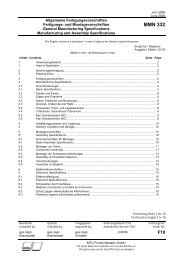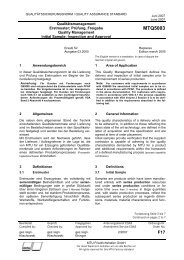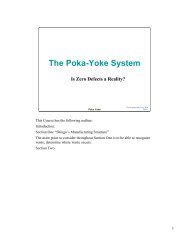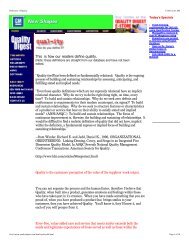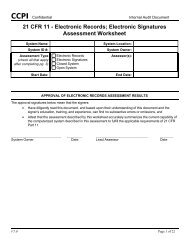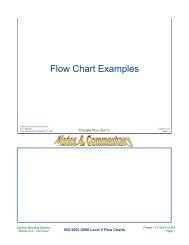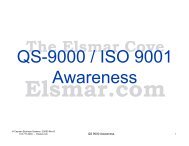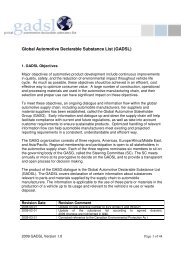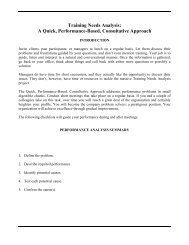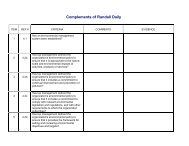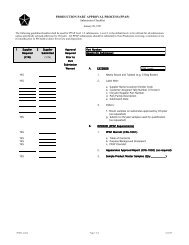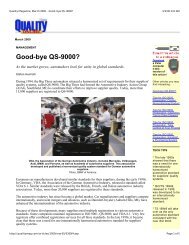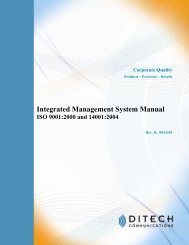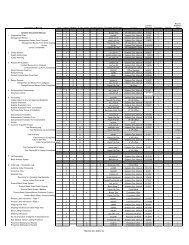SETTING THE STANDARD
SETTING THE STANDARD
SETTING THE STANDARD
You also want an ePaper? Increase the reach of your titles
YUMPU automatically turns print PDFs into web optimized ePapers that Google loves.
17101 ROTUNDA D RIVE<br />
D EARBORN, MICHIGAN 48121<br />
web.bli.ford.com<br />
<strong>SETTING</strong><br />
<strong>THE</strong><br />
<strong>STANDARD</strong><br />
2002
Note of Acknowledgement<br />
The re-engineering of Q1 has represented a substantial undertaking and would not<br />
have been possible without the contribution of our supplier partners. I would like to<br />
personally thank the following suppliers for their time and effort in the development<br />
of Q1 2002.<br />
• Autoliv Inc.<br />
• Benteler AG<br />
• Claes Johansson AB<br />
• Continental AG<br />
• Dana Corporation<br />
• Delphi Automotive Systems<br />
• Eaton Corporation<br />
• Federal Mogul Corporation<br />
• Intier Automotive<br />
• Johnson Controls, Inc.<br />
• Lear Corporation<br />
• Meridian Automotive Systems<br />
• Robert Bosch Corporation<br />
• Texas Instruments, Inc.<br />
• ThyssenKrupp Automotive<br />
• Tower Automotive, Inc.<br />
• TRW Inc.<br />
• Visteon Automotive Systems<br />
• ZF Friedrichshafen AG<br />
To these suppliers my sincere appreciation for a job well done. Thank you!<br />
Carlos Mazzorin
Q1 stands for everything Ford and its suppliers take pride in: excellence, consistency,<br />
customer satisfaction, and a drive to achieve more and more with each passing year. For<br />
years the Q1 flag has proudly flown over the best manufacturing facilities in the business,<br />
recognized industry-wide as the mark of supplier quality excellence.<br />
Today, Ford and its suppliers continue together on the journey toward ever-increasing<br />
quality. Q1 2002 builds on previous guidelines, incorporating the learning from years<br />
of Ford and supplier quality expertise.<br />
Q1 2002 has been streamlined to make it easier to use and more closely aligned with<br />
real customer satisfaction outcomes. Supplier Improvement Metrics (SIM) are now directly<br />
tied to Q1 status, so you’ll always know where you stand. Ford STA engineers and Lean<br />
engineers are receiving advanced technical training to better help suppliers along the<br />
path. And most important in this ‘move it or lose it’ world, continual improvement has<br />
been built into the Q1 program, to ensure that we stay in the lead.<br />
The Q1 journey, like the quest for excellence itself, never ends. But, like the quest for<br />
excellence, this journey offers many rewards along the way. We’re glad you’ve joined<br />
us on it.<br />
Carlos Mazzorin<br />
Ford Motor Company,<br />
Group Vice President, Global Purchasing<br />
and South America<br />
Q1 2002 information at https://web.bli.ford.com<br />
C O N T E N T S<br />
INTRODUCTION 3<br />
Q1 2002 REQUIREMENTS 7<br />
Q1 2002 SCORE 15<br />
CONSEQUENCES 17<br />
BENEFITS OF Q1 2002 19<br />
APPLYING FOR Q1 2002 21<br />
APPENDIX A - Capable Systems 25<br />
APPENDIX B - Ongoing Performance 29<br />
APPENDIX C - Manufacturing Site Assessment 33<br />
GLOSSARY 57<br />
Copyright ©<br />
2001 Ford Motor Company
INTRODUCTION<br />
Q1 works well. By recognizing quality achievement at the manufacturing<br />
site level, and by applying consistent, understandable metrics to ensure high<br />
quality, Q1 has become a quality brand name trustmark, both domestically<br />
and around the globe.<br />
But in today’s dynamic marketplace, companies that don’t improve get left<br />
behind. Q1 2002 is new and replaces previous expectations and requirements.<br />
Why Change: In the past, Q1 has been seen as a diploma of sorts, a<br />
one-time award that didn’t need to be renewed. Once the award was<br />
achieved, suppliers had limited interaction with Ford. Previous Q1 metrics<br />
weren’t predictive, so they didn’t always assure quality performance. But<br />
in a competitive industry, consistent quality and continual improvement are<br />
necessary for survival.<br />
What is Q1 2002?: It is a set of fundamental quality and<br />
manufacturing disciplines that ensure a supplier’s success and drive a<br />
supplier’s continual improvement. Suppliers are expected to hit a certain<br />
mark, but they’re also expected to put the tools in place to maintain<br />
excellence – and to improve with each passing year.<br />
Suppliers aren’t expected to achieve Q1 2002 independently – it is a<br />
relationship. Ford stands ready to offer suppliers its expertise and<br />
assistance throughout the Q1 2002 quality journey.<br />
Q1 2002 puts the discipline in place to achieve consistent excellence and<br />
guides cooperation between Ford and its suppliers for superior quality<br />
execution.<br />
2 3
Approach: Q1 2002 applies a few vital metrics to determine which suppliers<br />
qualify for Q1 – the same measurements will be used to establish who will<br />
keep Q1 status. It combines the best of the present Q1 with an increased<br />
emphasis on manufacturing fundamentals, variability reduction and ultimately<br />
customer satisfaction. A key component of Q1 2002 is the Manufacturing Site<br />
Assessment in order to evaluate overall manufacturing process capability and to<br />
provide the framework to achieve continual improvement. The assessment is<br />
specific to each manufacturing location, the capabilities of each site can be<br />
identified individually and suppliers can implement site-specific action plans.<br />
Q1 2002 is better than ever at measuring a manufacturer’s success –<br />
at identifying the best, and helping them to improve.<br />
Phase in Plan: Q1 2002 requirements are effective February 1, 2002. All<br />
suppliers are required to satisfy these requirements regardless of existing Q1<br />
status. This also applies to Q1 suppliers ‘in-good-standing’ in order for them to<br />
maintain their Q1 status.<br />
In addition, Q1 ‘probation’ is eliminated as a classification effective February<br />
1, 2002. Any supplier on ‘probation’ at that time will revert to ‘revoked’<br />
under Q1 2002.<br />
Suppliers to Mazda and Auto Alliance should contact the responsible<br />
supplier quality audit department regarding Q1 2002.<br />
4 5
2002<br />
What's New?<br />
What It Takes to Get Q1 2002<br />
• Third-Party Certification - QS-9000 or TS 16949,<br />
and ISO 14001; compliance to MS 9000, MMOG<br />
or Odette<br />
• Acceptable Manufacturing Site Assessment<br />
• Shipping History - 6 months which includes:<br />
– No Field Actions (with supplier responsibility)<br />
– No Stop Shipments (with supplier responsibility)<br />
– PPM less than 150% of Commodity Average for<br />
both production and service a), b)<br />
– Minimum Delivery Rating of 81 points for both<br />
production and service b)<br />
• Endorsement - STA and Customer<br />
• Q1 overall score at least 800 points<br />
Continuous Improvement<br />
• Threshold raised annually<br />
• Includes both performance metrics and<br />
Manufacturing Site Assessment<br />
Compared to Prior Q1<br />
– ISO 14001 is new<br />
– Site assessment is new<br />
– 12 months<br />
– No Field Actions (100% supplier responsibility)<br />
– Stop shipment is new<br />
– Production PPM competitive and improving; service<br />
PPM is new<br />
– Service delivery is new<br />
– Same<br />
– Q1 overall score is new<br />
– Annual threshold is new<br />
– Performance thresholds fixed; site assessment is new<br />
a) Negative points are only assigned for sites with PPM greater than 120.<br />
b) Applies only to FCSD receiving locations in the United States. Other regions will be phased in over time.<br />
Q1 2002 REQUIREMENTS<br />
Any external supplier whose manufacturing facility currently supplies<br />
production or service product to Ford is eligible for Q1 2002 consideration.<br />
Q1 2002 means that a supplier’s facility achieves excellence in these key<br />
areas: capable systems, ongoing performance, site action plan, satisfied<br />
customers and continual improvement.<br />
Capable Systems<br />
What are the capabilities of a supplier’s underlying systems?<br />
Q1 2002 evaluates this aspect of your business by your third-party<br />
certification ‘in-good-standing’ to QS-9000 or TS 16949 quality<br />
standards, and ISO 14001 certification, which assesses your<br />
environmental management system. Suppliers must also pass a<br />
MS-9000, MMOG, or Odette materials management system<br />
assessment. These systems are prerequisites to get and keep<br />
Q1 status and are discussed in more detail in Appendix A.<br />
Ongoing Performance<br />
What has a supplier’s performance history with Ford been?<br />
Q1 2002 uses a few key metrics of quality performance in<br />
determining a supplier’s Q1 score.<br />
Field Actions: Has Ford had to intervene because of a<br />
supplier failure?<br />
Stop Shipments: Is vehicle rework, modification or<br />
reinspection necessary due to product availability or quality?<br />
PPM Performance: Does a supplier deliver consistently<br />
high-quality products?<br />
Delivery Performance: Do products arrive on time, to the<br />
correct location, in the proper quantity and with the correct<br />
information?<br />
6 7
IMPROVING CUSTOMER SATISFACTION<br />
ELIMINATING VARIABILITY<br />
Ongoing Performance (continued)<br />
Q1 2002 reports these metrics as part of an updated Supplier<br />
Improvement Metrics (SIM) system. Suppliers will know their Q1<br />
2002 status and overall score, which is linked to their SIM summary<br />
report, on a monthly basis. The Q1 performance metrics are<br />
discussed in more detail in Appendix B.<br />
Q1 suppliers are responsible for the total quality of the goods and<br />
services they provide to Ford. This means that Q1 suppliers are<br />
responsible not just for their own sites, but for controlling the quality<br />
of any suppliers that provide them with product.<br />
Site Action Plan<br />
How do things measure up on-site?<br />
The Manufacturing Site Assessment evaluates whether the supplier is<br />
performing up to customer expectations. Site assessments are tools<br />
for suppliers to gage their performance. Q1 suppliers will perform<br />
a site assessment every six months to determine if they satisfy the Q1<br />
site expectations. Are systems and processes still operating at the<br />
same high level as when the supplier received Q1 status? Have Q1<br />
performance or manufacturing process thresholds advanced in order<br />
to meet or exceed new market demands or expectations?<br />
The Q1 site assessment addresses:<br />
Planning and Demonstration of Manufacturing Process<br />
Capability: What is a given facility capable of? How have<br />
they planned to best leverage their manufacturing and quality<br />
potential?<br />
Variability Improvements (Consumer Driven 6-Sigma):<br />
Does a supplier plan variability reduction techniques for new<br />
programs? Does the manufacturing process demonstrate<br />
ongoing variability reduction on current business?<br />
8 9
Site Action Plan (continued)<br />
Manufacturing Efficiencies: Does the supplier exhibit a<br />
systematic approach to lean manufacturing for current parts?<br />
Is surrogate data, First Time Through (FTT) and Overall<br />
Equipment Effectiveness (OEE) used for improvement of new<br />
programs? Does a supplier achieve lean manufacturing<br />
improvements on current business?<br />
Customer Satisfaction: Does a supplier achieve customer<br />
satisfaction improvements on current business and are these<br />
improvements documented in the Quality Operating System<br />
(QOS)?<br />
All suppliers must perform a Manufacturing Site Assessment by<br />
February 1, 2002; the site must be reassessed every six months.<br />
Ford STA may also conduct formal re-evaluation of a supplier’s<br />
Q1 status, on a case-by-case basis. This is influenced by historical<br />
quality performance, recent product launch concerns and potential<br />
impact on overall customer satisfaction. A more detailed discussion<br />
of the manufacturing site expectations is provided in Appendix C.<br />
Satisfied Customers<br />
Are a supplier’s customers satisfied with the service and quality<br />
they receive?<br />
Each supplier site must provide customer<br />
endorsements proving it consistently meets the needs of Ford<br />
customers. Each Ford plant that receives a supplier’s products,<br />
as well as Material Planning & Logistics (MP&L), Supplier Technical<br />
Assistance (STA), and Ford Customer Service Division (FCSD) for<br />
service parts, must provide the supplier with an endorsement.<br />
Sites currently Q1 do not need to obtain customer endorsement<br />
to meet Q1 2002 criteria.<br />
10 11
12<br />
Continual Improvement<br />
Are suppliers getting better each year?<br />
Continual improvement is built into Q1 2002. To maintain Q1 status,<br />
suppliers must keep a step ahead of the game, becoming better<br />
and better each year.<br />
With this in mind, the Q1 2002 thresholds for performance<br />
metrics and site assessment will be raised annually to encourage<br />
overall continual improvement. In the final analysis, the<br />
automotive customer of tomorrow will accept, and indeed will<br />
demand, no less.<br />
13
14<br />
Q1 2002 SCORE<br />
Score<br />
How are Capability, Performance, and Manufacturing Site Assessment<br />
tabulated to arrive at a final Q1 score?<br />
• Q1 Score: Suppliers must maintain an overall score of at least 800<br />
points for Q1 status – every site begins with a 1,000 point Q1 score.<br />
• Capable Systems: Sites must maintain certification to QS-9000/TS<br />
16949, ISO 14001, and compliance to MS-9000/MMOG/Odette<br />
(Appendix A).<br />
• Ongoing Performance: Sites gain or lose points based on their<br />
performance metrics and must perform to the minimum Q1 scoring<br />
thresholds (Appendix B).<br />
• Site Action Plan: Sites must meet all Q1 manufacturing site<br />
expectations and implement an effective corrective action plan based<br />
on timeliness and thoroughness (Appendix C).<br />
Sites that do not meet Q1 2002 requirements or fail to implement an effective<br />
corrective action plan based on the Manufacturing Site Assessment will lose<br />
250 points and Q1 will be revoked.<br />
This applies whether you are a new supplier or an existing Q1 location that<br />
wishes to keep Q1 status in 2002 and beyond. In addition, suppliers placed<br />
on Q1 revocation cannot gain points for positive performance.<br />
15
• Lack of Third-Party Certification – QS-9000 or<br />
TS 16949 and ISO 14001; compliance to MS-9000,<br />
MMOG or Odette<br />
• Unacceptable Manufacturing Site Assessment<br />
and ineffective corrective action plan implementation<br />
• Field Action (with supplier responsibility)<br />
• Stop Shipments - two or more<br />
(with supplier responsibility)<br />
• PPM exceeds Commodity PPM by 100% and site<br />
PPM is greater than 120 for either production<br />
or service a), b)<br />
• Delivery Rating less than 81 points for either<br />
production or service b)<br />
• Q1 overall score falls below 800 points<br />
Q1 Probation<br />
• Eliminated<br />
2002<br />
What it Takes to Lose Q1 2002<br />
– ISO 14001 is new<br />
– Site Assessment is new<br />
– 100% supplier responsibility<br />
– Stop shipment is new<br />
– Production PPM not competitive and<br />
improving; Service PPM is new<br />
– Service Delivery<br />
– Q1 overall score is new<br />
– Interim step to Q1 revocation<br />
a) Negative points are only assigned for sites with PPM greater than 120.<br />
b) Applies only to FCSD receiving locations in the United States. Other regions will be phased in over time.<br />
.<br />
CONSEQUENCES<br />
To ensure that Q1 retains the integrity and respect it commands in today’s<br />
industry, it is essential that all suppliers flying the Q1 flag fully comply with<br />
Q1 2002 requirements.<br />
REVOCATION OF Q1<br />
Ford knows its Q1 suppliers are dedicated to quality, and wants to see<br />
out-of-compliance sites get back on track. When a problem is identified,<br />
Ford will work with a supplier to identify the root cause and develop a<br />
corrective action plan. We will assist in implementing that plan, as well as<br />
monitoring the plan’s effectiveness, in line with our quality segmentation<br />
strategy.<br />
If, however, a supplier has not satisfactorily addressed the performance or<br />
customer satisfaction problem, the supplier’s Q1 status will be affected.<br />
A supplier’s overall Q1 score will be updated monthly to reflect the most<br />
recent six months of mature data. Suppliers must maintain a minimum of<br />
800 points beginning February 1, 2002.<br />
Certain situations will result in the recommendation to revoke a supplier’s<br />
Q1 status:<br />
• Loss of certification to ISO 14001, QS-9000 or TS 16949<br />
• Field Action with any supplier responsibility<br />
• Stop Shipments of two or more with supplier responsibility<br />
(Q1 impact may be waived based on supplier identification and timely<br />
resolution)<br />
• PPM level exceeds commodity PPM by 100% and site PPM is<br />
greater than 120<br />
• Delivery rating falls below 81 points<br />
• Overall Q1 score falls below 800 points<br />
• Manufacturing Site Assessment corrective action plan is ineffective<br />
based on timelessness and thoroughness<br />
These situations cannot be offset in the Q1 score by positive performance in<br />
other areas. STA will make the final determination on supplier Q1 status.<br />
To regain Q1, the supplier must satisfy all requirements for six consecutive<br />
months, including STA and customer endorsements, as appropriate.<br />
Suppliers reinstated after February 1, 2002 must also be third-party certified<br />
to ISO 14001.<br />
16 17
BENEFITS OF Q1 2002<br />
Your Q1 status has many benefits, most importantly, membership among the<br />
industry’s elite, with the associated respect and rewards:<br />
• Recognition: Flying the Q1 flag and displaying the Q1 plaque is<br />
a sign that your facility stands shoulder to shoulder with the best<br />
suppliers in the world.<br />
• Publicity and Advertising Privileges: Q1 status will enable you to<br />
advertise and publicize your company with the additional prestige<br />
of Q1.<br />
• Self-Certification: As a Q1 supplier, you will be able to self-certify<br />
to the PPAP requirements of QS-9000 and TS 16949.<br />
• World Excellence Award: As a Q1 supplier you will be eligible<br />
for this award, which acknowledges the best of the best, based on<br />
quality, cost, delivery, environmental responsibility, research and<br />
development, and technological innovation.<br />
• Preferred Status with Ford: Only Q1 facilities are considered in<br />
new product development and source selection. The increased<br />
accountability of Q1 2002 means that a supplier’s Q1 standing<br />
and quality score in SIM will have greater visibility in ongoing<br />
sourcing decisions.<br />
18 19
APPLYING FOR Q1 2002<br />
Ford Supplier Technical Assistance (STA) will help you through the Q1 process.<br />
The first thing you’ll need to do is contact your Ford STA site engineer.<br />
The STA site engineer will then guide the supplier through the steps necessary<br />
before the supplier makes a formal Q1 application. For example:<br />
• Is your site eligible for Q1 status?<br />
• Who are your manufacturing customers for Q1 consideration?<br />
• What is your classification: new supplier, new manufacturing site,<br />
current Q1 location certifying to Q1 2002?<br />
• What Manufacturing Site Assessment process will be used –<br />
Ford STA or self-assessment?<br />
Your facility will conduct a self-evaluation to ensure that you meet Q1 2002<br />
criteria. Once you believe your facility is ready, the next step is to obtain the<br />
necessary customer endorsements. These endorsements are valid for six<br />
months from the date of the signature on the endorsement documents.<br />
Sites currently Q1 do not need to obtain customer endorsement to meet<br />
Q1 2002 criteria.<br />
The next step in the Q1 process is formal application to Ford STA. When<br />
your self-evaluation shows your site to be up to Q1 standards, and you have<br />
collected the necessary customer endorsements, notify your STA site engineer<br />
in writing, along with documentation of your certification to QS-9000<br />
(or TS 16949) and ISO 14001, and compliance with MS-9000 (or MMOG,<br />
Odette).<br />
Ford STA will take it from there. A Q1 on-site evaluation may be scheduled<br />
to review your qualifications for Q1 2002. The responsible STA manager will<br />
provide a final recommendation based on demonstrated capabilities,<br />
performance metrics, Manufacturing Site Assessment and the overall Q1 2002<br />
points maintained during the prior six month period.<br />
20 21
APPLYING FOR Q1 2002 (continued)<br />
Administration<br />
Suppliers must have at least six consecutive months of production or service<br />
shipping history. If a supplier location has not shipped to Ford within the prior<br />
twelve months it is considered inactive and is no longer considered Q1.<br />
Q1 is a Ford-exclusive designation. Facilities that no longer ship to Ford may<br />
not advertise their Q1 status or fly the Q1 flag.<br />
For external production suppliers, Ford Purchasing Supplier Technical<br />
Assistance (STA) administers the Q1 program globally. For suppliers of<br />
service product, the responsible FCSD quality activity administers the Q1<br />
program globally.<br />
On-line Availability<br />
This document and information relating to Q1 2002 are accessible to<br />
suppliers on the Ford Supplier Network (FSN) at https://web.bli.ford.com.<br />
22 23
24<br />
APPENDIX A<br />
CAPABLE SYSTEMS:<br />
Basics<br />
Before a supplier is considered for Q1 2002, it must demonstrate system<br />
capability in several areas. These capabilities are prerequisites that suppliers<br />
must maintain to keep Q1 status.<br />
ISO 14001 – Environmental Management System<br />
Ford has led the way in the automotive industry by becoming the first<br />
automotive manufacturer to certify its global manufacturing facilities<br />
to ISO 14001. Q1 suppliers share a key role in our environmental<br />
commitment and efforts toward continual improvement.<br />
All existing Q1 supplier manufacturing sites are to be third-party certified to<br />
the ISO 14001 standard by July 1, 2003. Sites which are not certified at<br />
that time will lose 250 points and Q1 status. Suppliers are encouraged to<br />
pursue certification earlier than the deadline due to the potential benefits<br />
to the environment and expected savings through waste reduction. New<br />
suppliers and suppliers re-instated to Q1 status after February 1, 2002 must<br />
be third-party certified to ISO 14001.<br />
QS-9000 – Quality Management System<br />
TS 16949 – Supplier Quality System<br />
As one of the key stakeholders, Ford undertook the development of QS-9000<br />
in response to supplier requests to harmonize supplier quality requirements<br />
and assessment documents with other automotive manufacturers. Its goal is<br />
the development of fundamental quality systems that provide for continual<br />
improvement that emphasizes defect prevention and the reduction of<br />
variation and inefficiency within the value chain.<br />
Q1 suppliers are required to be third-party certified to QS-9000 or<br />
TS 16949 by February 1, 2002. Sites which are not certified at that time<br />
will lose 250 points and Q1 status.<br />
25
26<br />
MS-9000 – Material Management System Requirements<br />
MMOG – Materials Management Operations Guideline<br />
Ford developed MS-9000 and MMOG to drive the development and use<br />
of fundamental material management systems/processes that result in<br />
outstanding delivery performance, exceptional customer satisfaction and<br />
continual improvement.<br />
Q1 suppliers are required to submit an annual self assessment indicating<br />
compliance to MS-9000, MMOG or Odette (Volvo suppliers). Beginning<br />
2002, the appropriate self assessment summary page should be submitted<br />
via email to the responsible Material Planning & Logistics (MP&L) customer<br />
delivery specialist by August 1st of each year. As before, random on-site<br />
reviews of supplier compliance will continue. If a supplier is found to be<br />
out of compliance and its corrective action plan does not meet MP&L<br />
expectations based on effectiveness and timeliness, Q1 status may be<br />
jeopardized.<br />
27
Field<br />
Action<br />
Stop<br />
Shipment<br />
PPM<br />
Commodity<br />
Performance<br />
PPM<br />
6 Month PPM<br />
Delivery<br />
Rating<br />
a), c)<br />
c)<br />
c)<br />
Manufacturing<br />
Site Assessment<br />
Scoring Thresholds<br />
Supplier<br />
responsibility<br />
Supplier<br />
responsibility<br />
Production<br />
FCSD<br />
b), b d)<br />
Production<br />
FCSD<br />
bb)<br />
Production<br />
FCSD<br />
b)<br />
Metric Points Q1 Status<br />
1 in six months<br />
0<br />
1<br />
} in six months<br />
2 or more in six months<br />
Improvement vs. Commodity Avg.<br />
100 %<br />
75 % to 99%<br />
50 % to 74%<br />
25 % to 49%<br />
11 % to 24%<br />
0 % to 10%<br />
-1 % to -24%<br />
-25 % to -49%<br />
-50 % to -74%<br />
-75 % to -99%<br />
> -100%<br />
-<br />
0 PPM<br />
1 PPM to 60 PPM<br />
61 PPM to 100 PPM<br />
101 PPM to 250 PPM<br />
251 PPM to 500 PPM<br />
501 PPM to 750 PPM<br />
751 PPM to 1000 PPM<br />
1001 PPM to 1500 PPM<br />
> than 1500 PPM<br />
100 points<br />
97 to 99 points<br />
81 to 96 points<br />
below 81 points<br />
Supplier corrective action plan is ineffective<br />
a) Negative points are only assigned for sites with PPM greater than 120.<br />
-250<br />
points<br />
0 points<br />
-100 points<br />
-250 points<br />
+100 points<br />
+75 points<br />
+50 points<br />
+20 points<br />
+10 points<br />
0 points<br />
-25 points<br />
-50 points<br />
-100 points<br />
-150 points<br />
-250 points<br />
+100 points<br />
+50 points<br />
0 points<br />
-20 points<br />
-40 points<br />
-60 points<br />
-80 points<br />
-100 points<br />
-125 points<br />
+100 points<br />
+50 points<br />
0 points<br />
-250 points<br />
-250 points<br />
b) Applies only to FCSD receiving locations in the United States. Other regions will be phased in over time.<br />
c) Requires at least two months of shipping activity to receive any points.<br />
d) Requires at least four months of reject activity to receive - 250 points.<br />
Revoked<br />
Revoked<br />
Revoked<br />
Revoked<br />
Revoked<br />
APPENDIX B<br />
ONGOING PERFORMANCE: SCORING THRESHOLDS<br />
Every supplier starts with a Q1 score of 1,000 points. Based on calculations<br />
in the four metric categories, suppliers then gain or lose points, according to<br />
their performance. Suppliers must have a minimum of 800 points to<br />
maintain Q1 status.<br />
Some categories, like Field Actions, are absolute. A supplier must measure<br />
up to a certain standard in order to maintain Q1 status. If a supplier<br />
has any responsibility in a Field Action, the site loses 250 points, the Q1<br />
score drops to 750 and Q1 status is revoked.<br />
Other categories, like Parts Per Million (PPM), are measured on a sliding<br />
scale. If suppliers achieve or outperform PPM targets, they gain points,<br />
according to the percentage by which they outperform expectations.<br />
If they miss the mark, they lose points accordingly.<br />
As part of Q1 2002’s commitment to continual improvement, both the<br />
baseline threshold to achieve Q1 (800 points), and the thresholds necessary<br />
to succeed in each category and retain Q1 status, will increase as time<br />
goes on.<br />
Field Action (-250 points)<br />
Directly impacts Customer Satisfaction and Brand Image<br />
When Ford must intervene with a Field Action in a six month period in<br />
which the supplier has responsibility, the supplier site loses 250 points and<br />
Q1status.<br />
Stop Shipment (0 to -250 points)<br />
Directly impacts Customer Satisfaction<br />
If Ford experiences two or more Stop Shipments in a six month period, the<br />
supplier loses 250 points and Q1 status. Q1 impact may be waived if<br />
proactive intervention and timely resolution is demonstrated by the supplier.<br />
28 29
PPM (+100 to -250 points)<br />
Provides incentive to continually improve, increasing Customer Satisfaction<br />
A supplier can gain positive Q1 points by either outperforming the<br />
commodity PPM or by achieving 60 or less PPM – a site can lose points by<br />
exceeding the commodity PPM or exceeding 100 PPM. A site can gain or<br />
lose points for both production and service PPM. If multiple commodities are<br />
provided by a site, it will only receive points for the worst performing<br />
commodity for production and for service, respectively. For commodity<br />
PPM performance, negative points are only assigned for sites with PPM<br />
greater than 120. Should a supplier’s six month PPM level, for either<br />
production or service, exceed the ongoing commodity PPM by 100% or<br />
more, and the site PPM is greater than 120, the supplier loses 250 points<br />
and Q1 status.<br />
Sites can receive positive points when they outperform the commodity PPM.<br />
To gain or lose points for PPM performance, suppliers must have shipment<br />
activity in two of the prior six months. Suppliers to FCSD must have reject<br />
activity in four of the prior six months to lose Q1 status.<br />
PPM points are determined as indicated in the Scoring Thresholds table<br />
(page 28).<br />
Delivery Rating (+100 to –250 points)<br />
Drives excellence in communication and shipping performance<br />
A supplier can gain positive Q1 points for both production and service<br />
delivery performance based on the weighted six month average delivery<br />
rating. Suppliers must have shipment activity in two of the prior six months<br />
to gain positive points for delivery performance. If a site receives multiple<br />
production or service delivery ratings, it will only receive points for the worst<br />
production and service ratings, respectively. If a supplier’s production or<br />
service Delivery Rating falls below 81 points for the weighted six month<br />
average, for the last 2 mature months and for the current month, the supplier<br />
loses 250 points and Q1 status. Should a supplier’s delivery rating fall below<br />
81 points and there is no shipment activity in either the current month or one of<br />
the last two mature months, the site will receive zero points.<br />
Delivery points are determined as indicated in the Scoring Thresholds table<br />
(page 28).<br />
30 31
APPENDIX C<br />
Q1 2002 – MANUFACTURING SITE ASSESSMENT<br />
Principle: The Manufacturing Site Assessment defines Ford quality<br />
expectations and is a key component of Q1 2002. The assessment reviews<br />
the fundamental areas of any robust quality system by evaluating how well<br />
the site has planned for and demonstrated manufacturing process capability.<br />
Suppliers must demonstrate these fundamentals based on objective evidence<br />
in order to achieve and keep Q1.<br />
Satisfying the fundamental areas of the quality system is essential to<br />
delivering manufacturing efficiencies, variability reduction, and ultimately<br />
customer satisfaction. The site assessment will also establish continual<br />
improvement thresholds for manufacturing efficiency, variability reduction<br />
and customer satisfaction beginning in 2003 – suppliers are expected to<br />
meet these thresholds in order to get and keep Q1. Manufacturing<br />
efficiencies, variability reduction and customer satisfaction are the basis of<br />
continual improvement around which Ford and the supplier manufacturing<br />
site will establish a meaningful, ongoing collaborative relationship.<br />
Fundamentals: Suppliers will perform a full site assessment annually<br />
and a partial assessment every six months on the ‘focus’ areas asterisked (*)<br />
below. The site assessment addresses the following areas of manufacturing<br />
process capability:<br />
Planning for Manufacturing Process Capability<br />
- Quality procedures, QS-9000/TS 16949, QOS<br />
- FMEA’s/Control Plans *<br />
- Employee Readiness/Training Review<br />
- PPAP Review and Run at Rate Review<br />
- Manage the Change<br />
Demonstration of Manufacturing Process Capability<br />
- Sub-supplier Quality Management *<br />
- Control of Incoming Quality<br />
- Control Plans/Operator Instructions *<br />
- Process Variability Monitoring *<br />
- Gage Calibration and Use *<br />
- Part Identification, Nonconforming Parts, Packaging, Shipping<br />
- Testing, Engineering Specifications<br />
- Preventive Maintenance (PM)/Housekeeping*<br />
- Manufacturing Flow, Lean Manufacturing Metrics *<br />
- Problem Solving, Corrective Actions<br />
32 33
34<br />
ACCOUNTABILITY<br />
DELIVERING WHAT YOU PROMISE<br />
Fundamentals (continued)<br />
Suppliers will evaluate each area and based on objective evidence<br />
determine if they satisfy all Q1 manufacturing site expectations. Instructions<br />
for submission of the site assessment results can be found on FSN at<br />
https://web.bli.ford.com. A more detailed explanation of the site<br />
expectations, including the Q1 Site Assessment Summary, follows this<br />
section. Suppliers will share the manufacturing site self assessment findings<br />
with the responsible Ford STA activity upon request.<br />
Any area of the manufacturing site assessment not meeting Q1 expectations<br />
will require a site corrective action plan. The supplier will develop and begin<br />
implementation of the corrective action plan within 30 days of the site<br />
assessment. Failure to execute an effective and timely corrective action plan,<br />
as jointly determined by Ford and the supplier, will result in loss of 250 points<br />
and Q1 revocation. Ford STA will participate in the site assessment process,<br />
including corrective action plan follow-up, on a case-by-case basis.<br />
Continual Improvement: Beginning in January 2003, specific continual<br />
improvement thresholds will be established for manufacturing efficiency,<br />
variability reduction and customer satisfaction. Suppliers must demonstrate<br />
they meet these thresholds to maintain Q1 status. To achieve continual<br />
improvement, suppliers should develop and implement specific action plans<br />
for current business and new programs, as follows:<br />
Lean Manufacturing – suppliers will drive FTT and OEE improvement through<br />
specific actions documented in their Quality Operating System (QOS).<br />
Variability Reduction – suppliers will drive Ppk and Cpk improvements on all<br />
Significant Characteristics (SC), Critical Characteristics (CC) and High Impact<br />
to Customer (HICs) through specific actions documented in their QOS.<br />
Customer Satisfaction – suppliers will drive improvement in Things Gone<br />
Wrong (TGW) and repairs per 1000 (R/1000) by utilizing Global Quality<br />
Reporting System (GQRS) data and developing specific action plans that are<br />
documented in their QOS.<br />
Continual improvement of the manufacturing processes serves as the framework<br />
for achieving ongoing manufacturing efficiencies, variability reductions<br />
and customer satisfaction. Specific improvement thresholds will be provided<br />
on FSN at https://web.bli.ford.com. The following is a detailed explanation<br />
of the Q1 manufacturing site expectations.<br />
35
36<br />
EXPECTATIONS<br />
I. Planning for Manufacturing Process Capability<br />
(* denotes focus area)<br />
1) Quality Procedures/QS-9000/QOS<br />
• Supplier’s quality system is third-party certified to QS-9000<br />
or TS 16949 requirements.<br />
• Supplier’s quality system contains processes for all areas of<br />
the site assessment. The quality system is updated as needed<br />
to drive continual improvements. Supplier’s Management<br />
Team, including representatives from Manufacturing, Quality,<br />
Engineering and Human Resources perform these reviews.<br />
• Nonconformances identified in prior third-party audits are<br />
not repeated.<br />
• Supplier holds monthly QOS performance review meetings;<br />
supplier’s Management Team, including representatives from<br />
Manufacturing, Quality, Engineering and Human Resources,<br />
should perform these reviews.<br />
• QOS reviews include a review of all Ford SIM metrics, key<br />
process metrics and customer satisfaction metrics.<br />
• Plant-identified key QOS in-process metrics typically include:<br />
- Ppk/Cpk tracking mechanism. If supplier has processes<br />
that are robust enough to justify eliminating ongoing SPC<br />
data, the supplier must show evidence to support this<br />
practice<br />
- Gage R & R tracking mechanism<br />
- APQP tracking mechanism<br />
- Internal quality audit tracking mechanism<br />
- Lean tracking, such as First Time Through (FTT),<br />
Overall Equipment Effectiveness (OEE),<br />
Dock to Dock (DTD)<br />
37
38<br />
• Final customer QOS metrics typically should include:<br />
- TGWs short term and long term<br />
- Warranty costs per unit short term and long term<br />
- Warranty repairs per 1,000 short term and long term<br />
- Analysis of Field Return parts<br />
- Customer Satisfaction short term and long term<br />
• Action plans to drive continual improvement of the above<br />
metrics are tracked at QOS review meetings.<br />
• QOS metrics should focus on low and high time-in-service<br />
• Manufacturing site fully complies with all Q1 2002<br />
expectations.<br />
2) FMEAs/Control Plans*<br />
• All Ford parts have documented design and process failure<br />
mode and effects analysis (DFMEA, PFMEA) and Control<br />
Plans (or DCPs).<br />
• FMEA’s are reviewed annually and actions are taken<br />
to drive to lower Risk Priority Number (RPNs). A Pareto is<br />
used to focus on 1) severity, 2) the product of severity and<br />
occurrence, and 3) to identify high RPNs in order to<br />
prioritize actions to drive improvements.<br />
• All defect detection areas are reviewed and plans exist to<br />
move to defect prevention. There is evidence that defect<br />
prevention is replacing defect detection.<br />
• Suppliers have identified SCs and HICS on their PFMEAs<br />
and Control Plans for every Ford part or family of<br />
Ford parts.<br />
• Suppliers work with Ford Program Vehicle Teams (PVT),<br />
Program Engineering Office (PEO), and STA to establish<br />
final agreement of SCs and HICs. Suppliers obtain specific<br />
agreement from Ford for any parts not having SCs or HICs.<br />
• Supplier Control Plans ensure that all print dimensions and<br />
call-outs are always met.<br />
• Supplier verifies pass-through characteristics and ensures<br />
zero defects are at Vehicle Operations (VO) and final<br />
customer.<br />
• FTT is measured at the source, corrective actions are<br />
implemented and documented. The findings are extrapolated<br />
to similar processes.<br />
39
40<br />
• Control Plan is a result of appropriate quality planning and<br />
includes clear linkage between DFMEA and PFMEA.<br />
• Control Plans contain the following elements:<br />
- Operation number/name<br />
- Part name/part number<br />
- Inspection requirements<br />
- Specifications<br />
- Control methods<br />
- SC, CC, HIC and Engineering Specification (ES)<br />
requirements are identified and appropriate<br />
- SC, CC, HIC and ES control methods (in-process checks,<br />
process gaging and part gaging) are appropriate<br />
- Mistake proofing methods<br />
- In-process control methods<br />
- Sample size and frequency<br />
- Required tools, gages and other equipment<br />
- Reaction plans (reaction plans must clearly direct the<br />
operator on how to act when a process begins to go out<br />
of control or a product fails an inspection or test).<br />
3) Employee Readiness/Training Review<br />
• Supplier is responsible for assessing the skills required<br />
to perform all activities that affect product quality.<br />
• As part of the APQP process, employee staffing, skill<br />
requirements and training are identified, and support<br />
program timing.<br />
• Employees have a skills assessment, training plan and<br />
evidence of training.<br />
• Supplier ensures that only trained and qualified personnel<br />
are involved in all aspects of manufacturing of Ford parts.<br />
4) PPAP Review and Run at Rate Review<br />
• PPAP documentation must be no more than one year old<br />
at the time of initial PSW approval unless waived by the<br />
responsible STA engineer. Ford Powertrain plants require<br />
a copy of the PSW when parts are shipped.<br />
41
42<br />
• All PPAP documentation must contain the information<br />
per the PPAP manual published by Automotive Industry<br />
Action Group (AIAG) – this information must also be<br />
available for Ford review.<br />
• Suppliers require sub-suppliers to have a process in-place<br />
that effectively satisfies all PPAP requirements regardless of<br />
the sub-supplier business relationship with Ford.<br />
• Substance use restrictions conform with Ford specification<br />
WSS-M99P9999-A1 (refer to FSN, Environmental).<br />
• Run at Rate must be completed and supports the stated<br />
program requirements (at full-volume production levels) for<br />
all Ford parts.<br />
• Supplier monitors capacity and has a process to ensure<br />
on-going sufficient capacity on all Ford parts at all times.<br />
• Run at Rate must include the following elements and be<br />
performed on the entire process or the slowest operation<br />
(process bottleneck): machine available hours, shifts, days,<br />
machine downtime (planned and unplanned), machine<br />
change over, breaks and quality or scrap.<br />
5) Manage the Change<br />
• Supplier has a documented process to effectively implement<br />
post – Job 1 design changes, process changes or volume<br />
changes.<br />
• Supplier effectively reviews and updates its qualitysupporting<br />
documentation for these changes. Examples<br />
of documents that may require changes: FMEAs,<br />
Control Plans, Operator Instructions, Visual Aids and<br />
PPAP documentation.<br />
• Supplier follows a documented process to ensure that<br />
proper Ford approvals are gained prior to making<br />
process changes. The approval process will include<br />
use of Supplier Requests for Engineering Approvals<br />
(SREAs), Change Request/Concern Report (CR/CR)<br />
in Worldwide Engineering Release System (WERS),<br />
Management Alerts and revised PPAP documentation,<br />
as appropriate.<br />
43
II. Demonstration of Manufacturing Process Capability<br />
(* denotes focus area)<br />
1) Sub-supplier Quality Management *<br />
• Supplier has a defined process for managing its supply base<br />
including identification of those with high impact to quality.<br />
• Supplier requires sub-suppliers to be QS-9000 or TS 16949<br />
compliant and verifies subsupplier compliance by annual<br />
on-site assessment of high impact sub-supplier facilities.<br />
• Supplier requires PPAP for all parts from sub-suppliers<br />
(regardless of sub-supplier business relationship with Ford).<br />
• When a PPAP is submitted to Ford, all sub-supplier PPAPs<br />
are updated if the original PPAP documentation is more<br />
than one year old unless waived by the responsible Ford<br />
STA engineer.<br />
• Where Ford has defined an Engineering Specification (ES),<br />
or special characteristics that are the responsibility of the<br />
sub-supplier, the sub-supplier must show compliance with<br />
ES and special characteristics in its PPAP submission to the<br />
Tier one supplier.<br />
• Supplier requires sub-suppliers to take specific actions to<br />
ensure that all pass-through characteristics are to customer<br />
specifications.<br />
• Supplier must confirm sub-supplier compliance by review<br />
and approval of sub-supplier PPAP submission prior to<br />
incorporation of product in supplier manufacturing process.<br />
• Supplier conducts systemic reviews with sub-suppliers and<br />
assures implementation of corrective actions across supplier<br />
facilities for all issues resulting in stop ship or field action.<br />
2) Control of Incoming Quality<br />
• Supplier has a strategy for receiving inspection.<br />
• Incoming quality requirements are part of a control plan.<br />
If incoming quality inspections are made, there is evidence<br />
of the specification and compliance to the specification.<br />
If no incoming inspections are made, there is a rationale<br />
for qualifying sub-suppliers.<br />
44 45
46<br />
• Incoming Quality Operator follows a reaction plan if raw<br />
material or a purchased part is found to be out of<br />
specification.<br />
• Supplier has appropriate resources to manage sub-supplier<br />
quality including on-site assessment of high impact<br />
sub-supplier facilities.<br />
3) Control Plans/Operator Instructions *<br />
• Standardized operator instructions (including control plans,<br />
work instructions, job aids, check sheets, job set-up instructions<br />
and illustrations) are developed and available for operators.<br />
• Standardized operator instructions are legible, specific and<br />
controlled. The instructions are available in the area where<br />
the work is being performed and are followed by<br />
operators as written.<br />
• Reaction plans are clearly defined and protect Ford from<br />
nonconforming materials.<br />
• Control Plans are revised and updated when products or<br />
processes differ from those in current production.<br />
4) Process Variability Monitoring *<br />
• Supplier has determined appropriate statistical techniques.<br />
A key aspect of defect prevention is the use of SPC to<br />
indicate when action is necessary (such as adjustments<br />
and tooling changes), and conversely, when processes<br />
should be left alone.<br />
• Control charts are optimized for sample frequency, sample<br />
size, and appropriate chart type. SPC checks are<br />
performed on a timely basis and out-of-control conditions<br />
prompt corrective action as appropriate.<br />
• SPC data is maintained and monitored, and used to drive<br />
product and process improvement. Evidence of process<br />
improvements include: reductions in scrap, reductions in<br />
rework/repair, increases in first-time-through capabilities<br />
and reductions in machine downtime.<br />
47
• Ppk and Cpk levels are greater than 1.67 and 1.33,<br />
respectively, for all SC, CC and HICs.<br />
• Machine capability for SCs, CCs and HICs is monitored<br />
and improvements are made to drive variability<br />
reductions.<br />
• Machine capability for SCs, CCs and HICs must be<br />
demonstrated on all new equipment and tooling.<br />
5) Gage Calibration and Use *<br />
• Supplier ensures that all gages are available for use as<br />
identified in the control plan. The gage calibration and<br />
gage maintenance program ensures that back-up gages or<br />
a back-up gaging process is available to support inspections<br />
required by the control plan.<br />
• Variable gages are used for all SCs and CCs. HIC gages<br />
are per the control plan. All gages (company and<br />
employee-owned) are identified per the control plan.<br />
• Gage R & R is to conform with the guidelines in the AIAG<br />
Measurement Systems Analysis manual. Whenever gage<br />
R & R does not meet these guidelines, specific plans are<br />
in-place which adheres to the guideline.<br />
• Supplier has a documented ‘dropped gage’ policy that is<br />
followed by all employees. This ensures that only functional,<br />
in-specification gages are used.<br />
• Gage masters are traceable to a national standard. Gage<br />
calibration and maintenance is performed on an appropriate<br />
schedule and per specification.<br />
6) Part Identification/Nonconforming<br />
Parts/Packaging/Shipping<br />
• Supplier has a documented process for positive part<br />
identification in all stages of production, testing, laboratories,<br />
storage areas, office areas, etc.<br />
• Supplier has lot traceability of product after shipment to Ford.<br />
• Supplier takes measures to ensure that production processes<br />
control handling, storage, and packaging as to prevent<br />
damage or deterioration and preserve product quality.<br />
48 49
50<br />
• Returnable Ford dunnage is appropriately maintained and<br />
cleaned. Measures are taken to repair or replace worn or<br />
broken dunnage.<br />
• Supplier follows Ford packaging requirements identified on<br />
Ford form #1121R, or as directed in Direct Data Link (DDL).<br />
At pack-out, the Ford packaging guidelines are available for<br />
use and followed as required.<br />
7) Testing/Engineering Specifications<br />
• All inspections, measurements, and tests, including<br />
Engineering Specifications (ES) and Material Specifications<br />
(MS), are performed according to documented control<br />
plans, instructions, and/or procedures to ensure product<br />
requirements are met.<br />
• Appropriate reaction plans address what actions should<br />
take place if there is a test or inspection failure.<br />
• Reaction plans include directions on who is to act, if<br />
production is to stop, what shipments are to stop or to<br />
be recalled, and what actions are deemed necessary to<br />
protect and notify Ford.<br />
• Suppliers and sub-suppliers providing heat-treated<br />
components are required to meet Ford Manufacturing<br />
Standard W-HTX and demonstrate compliance using the<br />
Ford Heat Treat System Survey Guidelines. To reduce the risk<br />
of embrittlement, heat-treated steel components are required<br />
to conform with Ford material specification WSS-M99A3-A.<br />
8) Preventive Maintenance (PM)/Housekeeping *<br />
• Supplier has a maintenance system that contains reactive,<br />
preventive and predictive maintenance. The maintenance<br />
system supports process capability improvement.<br />
• The maintenance schedule has specific responsibilities<br />
assigned and the scheduled PM is performed as required.<br />
51
58 52<br />
• Management regularly reviews (at least quarterly) the status<br />
of the PM completion to plan. Management reviews corrective<br />
action plans to ensure any backlog (past due) maintenance has<br />
a plan to become current to the PM schedule. Management<br />
undertakes an evaluation to determine if there is a reduction<br />
of machine/process downtime.<br />
• The supplier has continual improvement plans for plant<br />
cleanliness, housekeeping, ergonomics and working conditions,<br />
and audits their facility at least monthly. There is evidence that<br />
the supplier management team is following the continual<br />
improvement plans.<br />
• Supplier takes measures to minimize foreign material, chips,<br />
debris, contamination, excessive oil, etc. where part quality<br />
can be negatively affected.<br />
9) Manufacturing Flow/Lean Manufacturing Metrics *<br />
• Supplier uses a Lean manufacturing system for current parts<br />
based on the use of 5S, standardized work, Total Preventive<br />
Maintenance (TPM) and empowered work teams. Work teams<br />
are responsible for problem solving at the work station. Batch<br />
sizes are minimized through accelerating equipment change<br />
over time.<br />
• A minimum of two Lean measurables show trends or history<br />
of improvement in the past six months. Lean measurables may<br />
include at least two of the following: Dock to Dock (DTD),<br />
First Time Through (FTT), Overall Equipment Effectiveness (OEE)<br />
and Value Add Percentage.<br />
10) Problem Solving/Corrective Actions<br />
• Supplier uses a structured problem solving method (e.g. Global<br />
8D) to address customer concerns and complaints.<br />
• Methods are established to communicate quality concerns to<br />
the supplier’s production and support personnel. 8D actions<br />
are submitted to the supplier’s management team for review.<br />
The 8D corrective actions are communicated to affected areas<br />
in the supplier’s organization.<br />
• Customer concerns in SIM and quality rejects show improving<br />
trends or are at zero level.<br />
53
54<br />
Q1 Site Expectations - Summary<br />
Category (*denotes focus area) Comments/Evidence Action Plans<br />
I. Planning for Manufacturing<br />
Process Capability<br />
1) Quality Procedures/<br />
QS-9000/QOS<br />
2) FMEA's/Control Plans *<br />
3) Employee Readiness/Training Review<br />
4) PPAP Review/Run at Rate Review<br />
5) Manage the Change<br />
II. Demonstration of Manufacturing<br />
Process Capability<br />
1) Sub-supplier Quality<br />
Management *<br />
2) Control of Incoming Quality<br />
3) Control Plans/<br />
Operator Instructions *<br />
4) Process Variability Monitoring *<br />
5) Gages Calibration and Use *<br />
6) Part Identification/Non Conforming<br />
Parts/Packaging/Shipping<br />
7) Testing/Engineering Specifications<br />
8) Preventive Maintenance/<br />
Housekeeping *<br />
9) Manufacturing Flow/Lean<br />
Manufacturing Metrics *<br />
10) Problem Solving/Corrective Actions<br />
Lead<br />
Responsibility<br />
Timing<br />
55
56<br />
GLOSSARY<br />
Delivery Rating: Suppliers are rated in relation to their overall delivery<br />
performance to each Ford receiving location based on advance shipment<br />
notice data and actual on-time shipment performance in meeting customer<br />
production and service requirements.<br />
FCSD: Ford Customer Service Division. Organization responsible to<br />
monitor suppliers providing service product to Ford Service receiving<br />
locations.<br />
Field Action: Field Actions are Recalls and Owner Notifications.<br />
Global Site Management Database: Used in supplier management<br />
and the collection of Q1 Capability and Manufacturing Site Assessment<br />
data.<br />
Commodity Codes: A grouping of like parts which is identified by a<br />
4 digit alpha-numeric code.<br />
PPM: Parts Per Million. A calculation that measures the number of<br />
defective parts received from a supplier per one million parts received.<br />
(Total Parts Scrapped/Returned + Total Parts Reworked) / Total Parts<br />
Received) x 1 million.<br />
SIM: Supplier Improvement Metrics. Web-based application that tracks<br />
and reports data on Supplier performance based on a standard set of<br />
metrics defined by Ford.<br />
Stop Shipment: Vehicles impounded or quarantined in the vehicle<br />
marshaling yard, rail cars, or convoy trucks that have not departed from<br />
their loading sites.<br />
57



